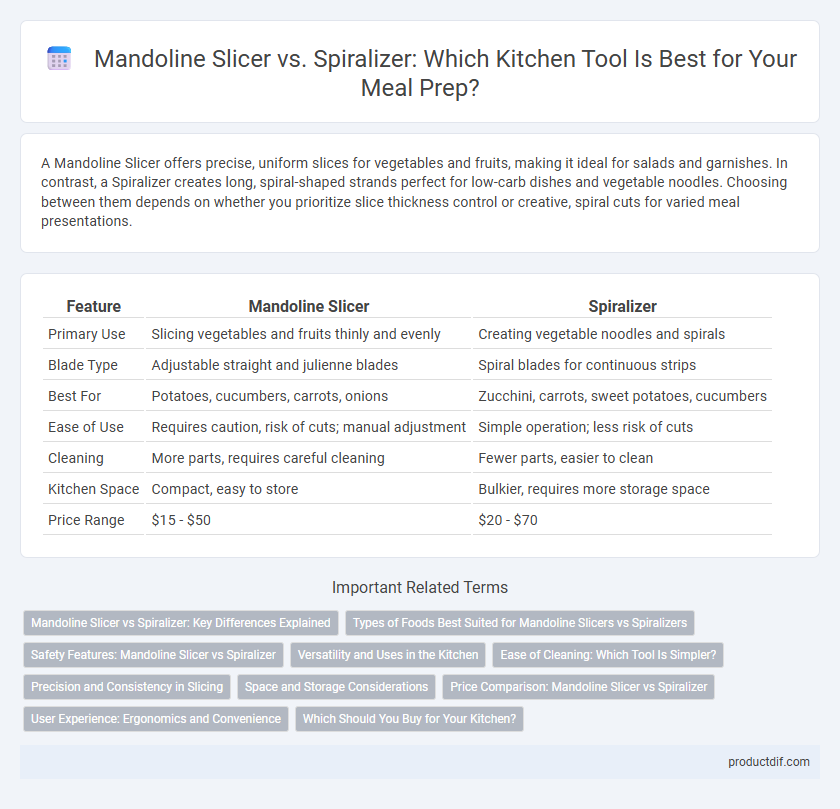A Mandoline Slicer offers precise, uniform slices for vegetables and fruits, making it ideal for salads and garnishes. In contrast, a Spiralizer creates long, spiral-shaped strands perfect for low-carb dishes and vegetable noodles. Choosing between them depends on whether you prioritize slice thickness control or creative, spiral cuts for varied meal presentations.
Table of Comparison
| Feature | Mandoline Slicer | Spiralizer |
|---|---|---|
| Primary Use | Slicing vegetables and fruits thinly and evenly | Creating vegetable noodles and spirals |
| Blade Type | Adjustable straight and julienne blades | Spiral blades for continuous strips |
| Best For | Potatoes, cucumbers, carrots, onions | Zucchini, carrots, sweet potatoes, cucumbers |
| Ease of Use | Requires caution, risk of cuts; manual adjustment | Simple operation; less risk of cuts |
| Cleaning | More parts, requires careful cleaning | Fewer parts, easier to clean |
| Kitchen Space | Compact, easy to store | Bulkier, requires more storage space |
| Price Range | $15 - $50 | $20 - $70 |
Mandoline Slicer vs Spiralizer: Key Differences Explained
Mandoline slicers create uniform, thin slices or julienne cuts of vegetables with adjustable blade settings, making them ideal for precise slicing tasks like potatoes or cucumbers. Spiralizers are designed to transform vegetables into long, curly strands or noodles, perfect for zucchini, carrots, or sweet potatoes used in salads or low-carb dishes. The key difference lies in their cutting style: mandolines excel at flat slices and strips, while spiralizers specialize in creating spiralized vegetable ribbons or noodles.
Types of Foods Best Suited for Mandoline Slicers vs Spiralizers
Mandoline slicers excel at producing uniform, thin slices of vegetables such as cucumbers, potatoes, and carrots, making them ideal for dishes like gratins, chips, and salads. Spiralizers are best suited for creating long, continuous spirals or noodles from firm vegetables like zucchini, sweet potatoes, and beets, perfect for low-carb pasta alternatives and decorative garnishes. Both tools enhance kitchen efficiency but cater to distinctly different food textures and presentation styles.
Safety Features: Mandoline Slicer vs Spiralizer
Mandoline slicers often include adjustable blades with hand guards and non-slip bases to reduce the risk of cuts during slicing, making them safer for thin, uniform slices. Spiralizers typically feature enclosed blades and secure vegetable holders that minimize direct contact with sharp edges, enhancing user safety while creating spiral cuts. Both tools require careful handling, but the design of spiralizers generally offers more protection from accidental injuries compared to traditional mandolines.
Versatility and Uses in the Kitchen
Mandoline slicers offer precise, uniform slices and are ideal for cutting vegetables and fruits into various thicknesses for salads, gratins, and garnishes. Spiralizers excel in creating curly vegetable noodles and decorative shapes, perfect for low-carb meals and creative plating. Both tools enhance kitchen versatility but target distinct preparation styles, with the mandoline prioritizing slicing consistency and the spiralizer emphasizing creative vegetable shapes.
Ease of Cleaning: Which Tool Is Simpler?
Mandoline slicers often feature fewer components and a straightforward design, making them quicker to disassemble and rinse under running water, while spiralizers tend to have multiple parts including blades and cranks that require more meticulous cleaning. Dishwasher-safe mandoline slicers reduce cleaning time significantly compared to spiralizers, which usually need hand washing to avoid damage. For ease of cleaning, mandoline slicers are generally simpler and more convenient in a busy kitchen environment.
Precision and Consistency in Slicing
Mandoline slicers offer unparalleled precision and consistency with adjustable blades that create uniform slices ranging from paper-thin to thick cuts, ideal for salads and gratins. Spiralizers excel in producing consistent, evenly shaped vegetable spirals or ribbons, perfect for healthy pasta alternatives and garnishes. Both tools enhance kitchen efficiency, but the mandoline's blade control provides superior accuracy for varied slicing thicknesses.
Space and Storage Considerations
Mandoline slicers typically have a compact, flat design that makes them easy to store in kitchen drawers or hang on hooks, optimizing limited space. Spiralizers often come with bulkier components and multiple attachments, requiring more storage room and dedicated cabinet space. Choosing between the two depends on your available kitchen space and how frequently you plan to use each tool.
Price Comparison: Mandoline Slicer vs Spiralizer
Mandoline slicers generally cost between $20 and $80, offering a budget-friendly option for precise slicing tasks. Spiralizers typically range from $15 to $50, often providing more affordable models for creating vegetable spirals. The price difference is minimal, but the choice depends on specific kitchen needs and desired functionality.
User Experience: Ergonomics and Convenience
Mandoline slicers offer precise, uniform cuts with adjustable thickness settings, ensuring efficient preparation of vegetables while maintaining user safety through hand guards and non-slip bases. Spiralizers provide ergonomic handles and compact designs, facilitating comfortable grip and easy operation for creating decorative vegetable spirals without excessive effort. Both tools enhance kitchen convenience, but mandolines excel in versatility while spiralizers prioritize ease of use for specific tasks like making spirals or noodles.
Which Should You Buy for Your Kitchen?
Mandoline slicers offer precise, uniform cuts ideal for slicing vegetables like cucumbers, potatoes, and carrots, making them essential for salads and chips. Spiralizers excel at creating vegetable noodles and curly garnishes, perfect for low-carb meals and creative plating. Choose a mandoline for versatile slicing and shredding, while a spiralizer suits kitchens focused on healthy, vegetable-based dishes.
Mandoline Slicer vs Spiralizer Infographic

 productdif.com
productdif.com